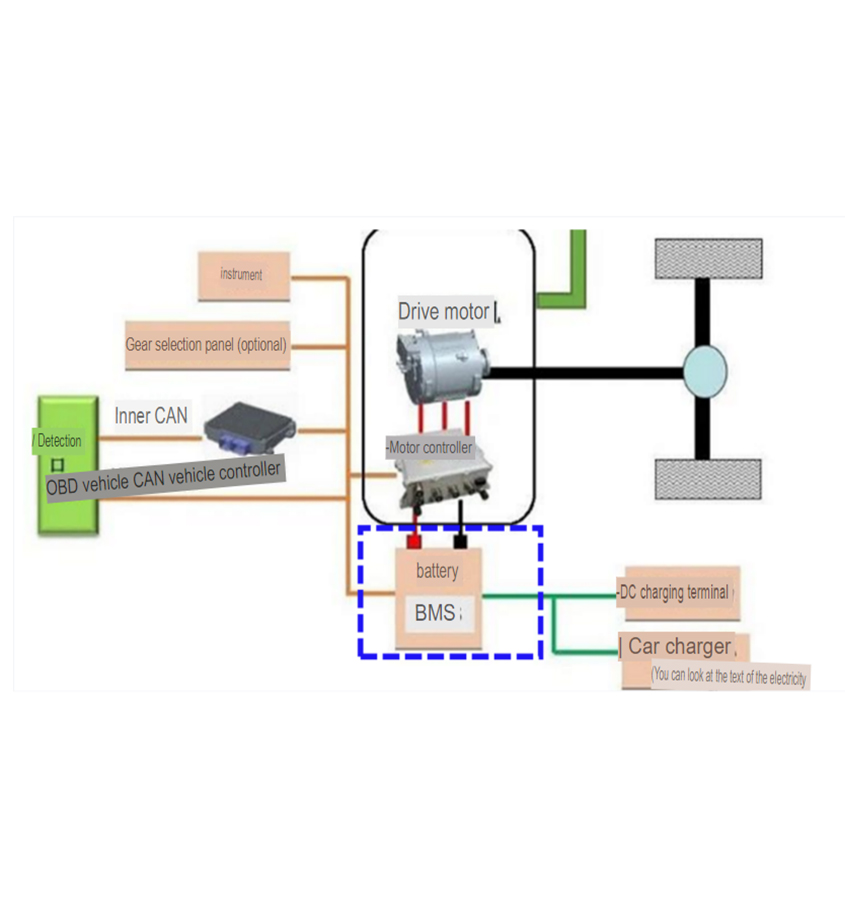Introduction
The battery pack high voltage system is designed to control power flow to and from the cells and to maintain the power level within the design envelope. Batteries with high energy density, high power density, and long cycle life are needed to support the faster introduction and smooth integration of electric vehicles within our society. Choices related to both the materials used in Li-ion batteries and the methods used to manufacture the batteries influence their performance. Therefore research is underway to develop novel electrode and electrolyte materials and battery manufacturing methods.
Buy Now: Semco Infratech – SI Battery Charge & Discharge Cabinet Tester – SI BCDS 100V 20A 4CH.
1. The composition of the battery pack:
A battery pack includes a battery pack case, a battery pack connected in series and parallel, a battery management system (BMS), a wiring harness (strong & weak current), strong current components (relays, resistors, fuses, Hall sensors), etc.

2. Why are pre-charge relays and pre-charge resistors added to the battery pack components?
This question needs to first understand the bus capacitance of the new energy vehicle: In the motor controller, the DC power of the battery pack is used as the input power supply, which needs to be connected to the motor controller through the DC bus. This method is called DC-LINK or DC support, and the capacitors are called bus capacitors or support capacitors or DC-Link. Capacitance. Since the motor controller obtains a pulse current with a high RMS value or a high peak value from the battery pack, it will generate a high pulse voltage on the DC support, which makes the motor controller unbearable, so it is necessary to select a bus capacitor for the connection.

The front end of the battery has a large capacitor C (this capacitor is the above-mentioned bus capacitor). If there is no pre-charge, the main positive relay is directly connected to the capacitor C. At this time, the battery voltage is high, and the voltage on capacitor C is close to 0. It is equivalent to an instantaneous short circuit. The load resistance is the resistance of the wire and the contact of the relay. The resistance value is very small. According to Ohm’s law, the voltage is large, the resistance is small, and the instantaneous current can reach tens of thousands of amperes. At this time, the main relay will definitely be damaged. In the pre-charging process, the main positive relay is disconnected first, and the pre-charging circuit formed by the pre-charging relay and the pre-charging resistor are connected first. Assume that the resistance value of the pre-charging resistor is above 30Ω, and the loop voltage is assumed to be 300 V. At this time, the maximum loop current is also just 10A, the capacity of the pre-charge relay is above 10A, and the pre-charge circuit is safe. Therefore, the function of the pre-charge relay is to control the opening and closing of the pre-charge circuit, and the function of the pre-charge resistor is to limit the current.

3. Hall sensor
Generally, the negative side of the circuit is used to measure the charge and discharge current value of the entire circuit.
Buy Now: Semco Infratech – SI Battery Management System Tester – SI BMST 1-32S 60/120A with cabinet
4. BMS (Battery Management System)
There are two types of BMS: integrated type and discrete type. The discrete type is mainly divided into three modules, the main control module (BCU), the slave control module (BMU), and the insulation monitoring module (HVU). The discrete system architecture diagram is as follows:

(1). Components of BMS

(2) Main functions of each part of BMS
BCU (main control module): Receive and comprehensively judge the basic information of the battery, calculate the SOC, upload or send control commands, carry out external relay control, vehicle CAN communication, charging CAN communication, intranet CAN communication, data storage, input and output signals Detection, charging and discharging current acquisition; BMU (battery information monitoring module, slave module): single battery voltage acquisition, battery temperature acquisition, battery balance management, single box battery thermal management, intranet CAN communication; HVU: (insulation monitoring module) battery pack insulation monitoring, battery pack total voltage monitoring, motor controller pre-charge voltage detection, intranet CAN communication;
Conclusion
Lithium-ion battery packs for electric vehicles have large battery capacity, many series and parallel connections, complex systems, and high-performance requirements such as safety, durability, and power. In addition, the safe working area of the lithium-ion battery pack is limited by temperature and voltage. If it exceeds the allowable range, the performance of the battery pack will accelerate decay, and even safety problems may occur. Therefore, the battery management system is indispensable and extremely important.
More Articles:
Failure analysis of lithium batteries is a science,
Overview of Lithium Batteries,
The packaging form of lithium-ion battery is better,
Causes Reconditioning Of Battery Vulcanization,
Lithium-ion Battery Process Details,
Lithium battery overcharge mechanism and anti-overcharge measures.,
Factors Affecting The Performance of High Power Lithium-ion Batteries,
Electrical measurement of lithium-ion batteries,
Functions of the Battery management system (BMS),
Why do electric vehicles get slower and slower after riding,
why can’t Electric Cars of the same model overt beat,

